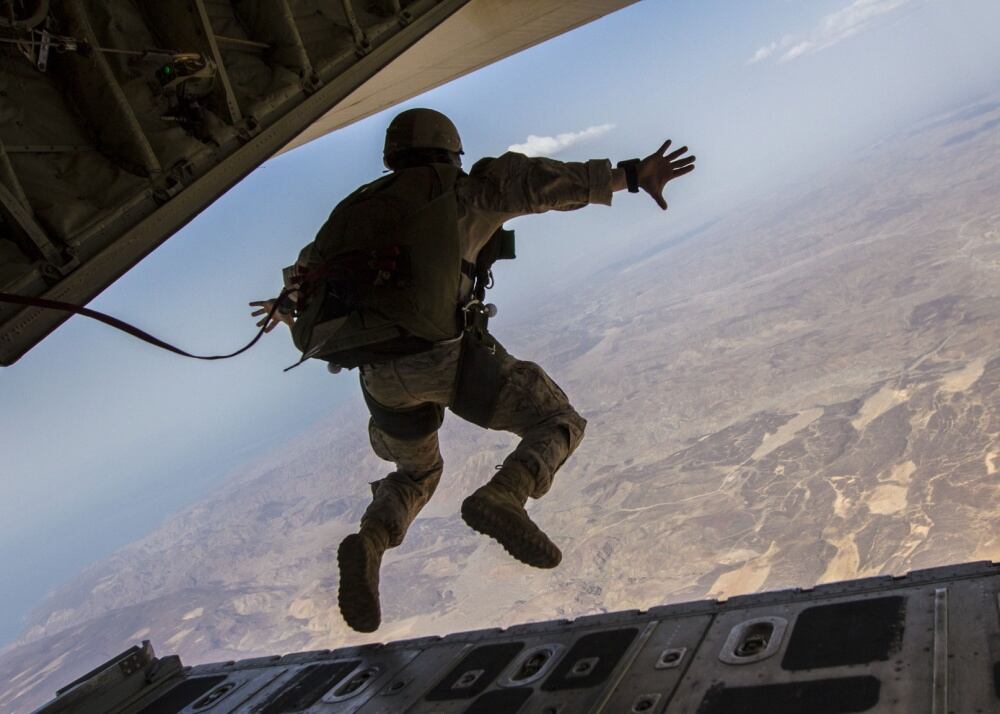The Corps’ multimission parachute system, or MMPS, has been in service for over a decade.
But now the Corps says it’s inadequate to meet the requirements of today’s force and brings some safety concerns.
To modernize the Corps’ parachute insertion capability, the Marines have spent the past several years researching potential replacements for the MMPS, eventually deciding to move forward with the enhanced multimission parachute system.
According to Barbara Hamby, a spokeswoman for Marine Corps Systems Command, the Corps awarded a contract in January 2018 to Airborne Systems North America for the new parachute, and the Corps plans to procure more than 1,000 parachutes, with the first fielding expected by the end of 2021.
RELATED

But the fiscal year 2018 annual defense legislation, Congress threatened to withhold nearly 20 percent of funds for the procurement of the new parachute until the secretary of the Navy submitted a report to congress detailing the need for the new parachute and whether the service explored existing alternatives across the military.
That report, obtained by Marine Corps Times via a Freedom of Information Act request, detailed that the Corps, as early as 2004, had put out a statement that the force needed a parachute canopy with an offset capability of 25 km under ideal weather conditions and zero relative wind.
The offset allows a recon or special operations team to glide long distances to an objective after exiting an aircraft.
In 2016 the Corps updated its parachute program requirements, seeking higher glide ratios that could insert a commando team deeper to its objective, new weight support and altitude deployment ranges, and a need for more precise landings with the ability to drop Marines within a 75- by 100-meter drop zone.
The Corps said the new changes would also make the parachute safer, provide better standoff between jumper and aircraft, and result in better interoperability with new airframes like the MV-22 Osprey. The Osprey was not yet operational when the MMPS was being designed, according to the report.
In its report to lawmakers, the Corps said the current fielded parachute was “unable to meet these requirements” and is “obsolete for today’s Marine Corps.”
“While assessing the MMPS under the Army’s specifications, the Marine Corps discovered 33 overall hazards, 30 of which were remote but catastrophic risk hazards, such as canopy failures, spinning, tumbling, opening shock, and drogue failure. In particular, an MMPS drogue failure resulted in a 2013 parachutist death,” the Corps’ report detailed.
That assessment drove the Corps to adopt some industry standards and tests for the EMMPS instead of applying the Army’s MMPS parachute specifications.
The Corps looked at both the Army’s RA-I chute and the PARIS, Special Application Parachute, and found neither met the standards the Corps was looking for in its new parachute, citing some safety concerns.
The Army’s RA-1, the Corps argued, did not have a self-set drogue parachute, which helps stabilize a jumper after exiting the aircraft and mitigates tumbling during freefall. A drogue parachute can help slow a jumper during free-fall and provides added stability and control.
The Marines Corps, in its research, said it found “parachutist instability” was a factor in at least two jump fatalities, and thus any new chute would need a self-set drogue chute.
And while the PARIS, special application parachute, or SAP, was found to have a higher glide ration than the EMMPS, the Corps said weight restrictions could become a safety hazard.
The SAP has an all-up weight restriction between 240-450 pounds, meaning Marines under 240 pounds, including kit would not be able to jump the parachute.
However, the SAP does almost double the insert offset capability the Corps is seeking in its new parachute.
According to a thesis authored by Sam Brasfield for the Naval Postgraduate School on military air insertions, a team jumping the SAP at 25,000 feet can glide nearly 40 kilometers to their objective, and with favorable wind conditions that distance could stretch nearly 75 kilometers.
“However, Marine Corps mission capabilities do not require the higher glide ratio of the SAP,” the report stated.
“For mission flexibility, the Marine Corps removed the SAP requirement to employ instead a hybrid parachute with performance parameters at requisite payloads ranging between the parameters of the current MMPS 's main canopy at the low end and the parameters of the SAP’s main canopy at the high end,” the report added.
The Corps said that new equipment training for the new EMMPS chute will only run about $180,000 and $100,000 for new technical manuals.
The Marines added that the new chute is a “much-needed upgrade in terms of operational performance, reliability, and safety.”
Shawn Snow is the senior reporter for Marine Corps Times and a Marine Corps veteran.





